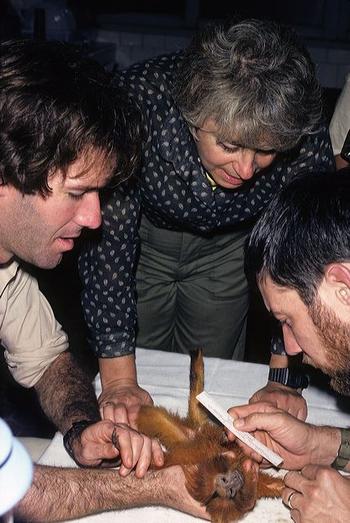
In my first week of interning at the Archives, I assisted Assistant Archivist Jennifer Wright with a records transfer from the National Zoological Park. My first thought was, "What in the world are we going to pick up at the zoo?" I was pleasantly surprised to meet Lou Ann Dietz and James M. Dietz, waiting for us on a small loading dock tucked into a hidden zoo entrance. Sitting on that loading dock were boxes—dozens of them—filled with records they had maintained documenting the Golden Lion Tamarin Conservation Program. The Dietz's worked with this National Zoological Park program, conducting field research, training locals to record observations, and spearheading educational campaigns in an effort to save the golden lion tamarin, a small endangered monkey native to Brazil.
 In 1992, the Dietz's were founding members of the Associação Mico-Leão Dourado (AMLD), a Brazilian non-profit which took on most of the oversight of the conservation efforts. Today Lou Ann and Jim Dietz continue their efforts by serving as President and Vice-President, respectively, of Save the Golden Lion Tamarin, a United States non-profit that supports and promotes the AMLD. The bulk of the records they were transferring consisted of handwritten field observations, with other records documenting the oversight of the program and its activities. The Dietz's no longer actively needed these records for their work and were sending them to the Archives where they would be properly preserved and where other researchers could benefit from them. The couple explained how they had organized their records and the subject matter of the collection. We quickly formed an assembly line and loaded up the van with the boxes.
In 1992, the Dietz's were founding members of the Associação Mico-Leão Dourado (AMLD), a Brazilian non-profit which took on most of the oversight of the conservation efforts. Today Lou Ann and Jim Dietz continue their efforts by serving as President and Vice-President, respectively, of Save the Golden Lion Tamarin, a United States non-profit that supports and promotes the AMLD. The bulk of the records they were transferring consisted of handwritten field observations, with other records documenting the oversight of the program and its activities. The Dietz's no longer actively needed these records for their work and were sending them to the Archives where they would be properly preserved and where other researchers could benefit from them. The couple explained how they had organized their records and the subject matter of the collection. We quickly formed an assembly line and loaded up the van with the boxes.
A week later I was tasked with processing a related collection of records documenting the Golden Lion Tamarin Conservation Program (Accession #11-217, National Zoological Park, Dept. of Zoological Research, Golden Lion Tamarin Conservation Program Records, c. 1970-2002), which had been transferred to the Archives in the fall of 2010. According to the non-profit Save the Golden Lion Tamarin: "The Golden Lion Tamarin Conservation Program was created in 1983 to rescue, protect, and conserve the golden lion tamarins in their natural habitat." As I rehoused these papers I realized that the Dietz’s formed an integral part of the team implementing the Golden Lion Tamarin Conservation Program. Standing on the loading dock that day, the Dietz’s struck me as compassionate and determined people; reading through this collection only solidified my thoughts.

Though our interaction was brief, our parting triggered something in me. The Golden Lion Tamarin Conservation Program means a great deal to the Dietz’s, and they were emotional as they passed their many years of hard work on to the Archives. I experienced a connection with the Dietz’s as the records passed from their hands to ours, and their tear-filled eyes said goodbye. This experience has shown me something that the books and lectures of my archival education are hard-pressed to describe: the connection between people and the physical history they create. I have come to see the records the Archives collects as representing people. These records illustrate the lives and mark the existence of people working in conjunction with the Smithsonian Institution, and they legitimize discoveries and work of researchers and other staff through their existence. Now every researcher I see in the reading room of the Archives makes me a little jealous. I wonder—who do they get to meet today?
Read about the work of Devra Kleiman (1942-2010) who headed the Golden Lion Tamarin Conservation Program in these previous blog posts.
Produced by the Smithsonian Institution Archives. For copyright questions, please see the Terms of Use.

Leave a Comment